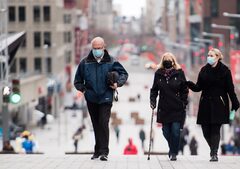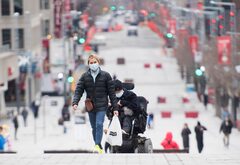Canada needs a new and aggressive strategy to reduce COVID-19 cases to zero, a group of doctors and infectious disease experts is urging, as the rates of infection reached record highs in various parts of the country over the weekend and hospitalizations and deaths continued to rise.
With provinces such as Alberta, Ontario and Quebec recording more than 1,000 new cases a day, some doctors and politicians have proposed implementing “circuit breakers," two-week economic lockdowns to bring COVID-19 cases under control. But as public health experts push for tighter restrictions, with some arguing that even two weeks wouldn’t be enough, economists are warning that a full-blown lockdown could add hundreds of billions of dollars in new government debt.
Andrew Morris, an infectious diseases specialist at Toronto’s Sinai Health and University Health Network, said brief and sporadic circuit breakers will only prolong the pain and the country’s current approach has resulted in “muddled communication,” with various regions grappling with different acceptable rates of infection. Instead, he and his colleagues, who have taken to social media under the hashtag #COVIDzero, are calling on governments and public health officials to work together to stamp out community spread of the virus altogether – a goal that requires longer and stricter restrictions in the interim.
How an Australian state beat its second wave of COVID-19
How many coronavirus cases are there in Canada, by province, and worldwide? The latest maps and charts
“If you do it just for a few weeks, we’re going to have it rise again,” Dr. Morris said. “I think we need to understand that we need to drive the number of cases dramatically down. That’s going to take weeks and weeks.”
If COVID-19 cases can be brought down as close to zero as possible and maintained at that low level, he said, Canadians will not have to worry about further lockdowns, the need to shut down businesses and schools, and more deaths in long-term care, retirement homes and group homes.
“Every other approach leads us to repeated waves,” he said.
About 4,613 new COVID-19 cases and 63 deaths were reported across the country as of Nov. 14, with Ontario, Quebec, Alberta, Manitoba and Saskatchewan reporting record-high numbers over the weekend. The number of people experiencing severe illness was also climbing, with a seven-day average of 1,438 individuals hospitalized, and 280 in intensive care units across the country.
In a statement on Sunday, Theresa Tam, Canada’s chief public health officer, said the situation is putting pressure on health resources and forcing hospitals in several areas of the country to cancel elective operations and procedures. Ontario’s William Osler Health System, which runs hospitals in hard-hit Brampton and Etobicoke, says it has temporarily cancelled some elective operations. Trillium Health Partners, which sees some of the highest numbers of COVID-19 patients in Ontario, said its planned operations and procedures are continuing as scheduled, but the hospital was at 101-per-cent capacity across all sites as of Friday.
Change in COVID-19 hospitalizations since Nov. 1
Percentage change in hospitalizations from Nov. 1 to Nov. 13
THE GLOBE AND MAIL, SOURCE: PROVINCIAL HEALTH DEPARTMENTS
DATA
SHARE
×
×



Earlier this month, Alberta’s chief medical officer of health Deena Hinshaw said that province was considering a short lockdown, after doctors and infectious disease experts called for a two-week “circuit breaker.” On Friday, Ontario Opposition Leader Andrea Horwath also urged for targeted hot spots to be placed back under modified Stage 1 restrictions for two weeks.
Steve Buick, a spokesman for Alberta’s Minister of Health, said the demand to reduce cases to zero, or near zero, is extreme.
STORY CONTINUES BELOW ADVERTISEMENT
“It would do more harm than good by throwing hundreds of thousands of people out of work indiscriminately in an economic crisis, disrupting kids' education, and disrupting community life in ways that do real harm to mental health and well-being,” he said in an e-mail.
But Irfan Dhalla, a physician at St. Michael’s Hospital and a vice-president of Unity Health Toronto, said countries like Australia and New Zealand, as well as Atlantic Canada, have demonstrated how a strategy that keeps rates close to zero can save lives and allow businesses to reopen fully.
“It was speculation, I suppose, in April or May to say that a COVID zero approach would be the best approach. In November, I don’t think it’s speculation any more,” Dr. Dhalla said.
A second lockdown would be costly. Already Canada’s net federal debt is on track to hit $1.2-trillion by the end of the current fiscal year next March, with the federal government projecting a $343-billion deficit. And that amount doesn’t take into account additional spending announced this fall as part of changes to income-support programs for individuals and wage subsidies for businesses.
Jack Mintz, president’s fellow at the school of public policy at the University of Calgary, said policy makers should avoid a broad freeze and exempt parts of the economy that have low transmission risks but result in high costs if shut down. School and daycare shutdowns, for example, create enormous economic fallout because they pull parents out of the work force, Mr. Mintz said.
Ottawa should also target its fiscal response to any new lockdown, Mr. Mintz said, pointing to figures released last week by the Organization for Economic Co-operation and Development that show Canadians' household income actually rose during the first wave of the coronavirus.
The OECD study said per capita household income rose 11 per cent in the second quarter of 2020 from the first three months of the year, the largest increase for any of the 19 OECD member countries included in the analysis. Only the United States, with a 10.1-per-cent rise in per capita household income came close to Canada’s increase. The agency said that in both countries, the spike in household income came from broad-based payments to individuals.
Mr. Mintz said the increase in Canadians' average household income means that Ottawa overcompensated for the financial effects of the pandemic, spending $200-billion more than if it had simply maintained incomes at pre-pandemic levels. One example of that overcompensation, he said, was the federal government’s decision to allow part-time workers to claim the $500 weekly Canada Emergency Response Benefit, allowing those individuals to boost their incomes substantially during the spring and summer.
“You’ve got to ask the question, did we go overboard?”
Sign up for the Coronavirus Update newsletter to read the day’s essential coronavirus news, features and explainers written by Globe reporters.

CORONAVIRUS INFORMATION
The Zero Canada Project provides resources to help you manage your health, your finances and your family life as Canada reopens.
Visit the hub
Hide info
13 HOURS AGO

Canada nears 300,000 total COVID-19 cases
17 HOURS AGO

Quebec reports 1,211 new COVID-19 cases, 15 additional deaths linked to coronavirus
19 HOURS AGO

Ontario reports 1,248 new COVID-19 cases, 29 additional deaths linked to coronavirus
20 HOURS AGO

FOLLOW WENCY LEUNG AND PATRICK BRETHOUR ON TWITTER @WENCYLEUNG @PATRICKBRETHOUR
REPORT AN ERROR EDITORIAL CODE OF CONDUCT
229 COMMENTS
SHOW COMMENTS
MORE FROM CANADA

GLOBE EVENTS
The Future of Cities-exploring work, transportation, housing and culture
Join The Globe, Tortoise Media and a group of Canadian and international experts as they explore who and what will be the driving force behind how cities will transform.
Register for FREE with code GlobeDigital | Webcast Thurs Nov 19, 8:00am to 2:00pm EST
REGISTER NOW

OPINION
Rethink mink: Denmark’s COVID-19 outbreak linked to fur farms should worry Canadians
JESSICA SCOTT-REID

COVID-19 cases surge among First Nations in Manitoba during second wave

Morning Update: Doctors push aggressive strategy to control coronavirus

Pandemics have changed cities in the past, and they will again Subscriber content

OPINION
Canada needs a bold pro-growth strategy for both pandemic recovery and a successful future
CRAIG ALEXANDER
[IMG alt="Shoppers walk past a PC Financial kiosk at a newly opened Loblaws location, in Toronto, on Friday, Sept., 11, 2020. (Christopher Katsarov/The Globe and Mail)
"]https://www.theglobeandmail.com/resizer/knpuwtCZPzQnwZWMg4oSXz9SLlk=/220x0/smart/filters:quality(80)/cloudfront-us-east-1.images.arcpublishing.com/tgam/F5NHCA2OL5D4NE3XCRJCI36IWE.JPG[/IMG]
Skip footer navigation
© Copyright 2020 The Globe and Mail Inc. All rights reserved.
351 King Street East, Suite 1600, Toronto, ON Canada, M5A 0N1
Phillip Crawley, Publisher

With provinces such as Alberta, Ontario and Quebec recording more than 1,000 new cases a day, some doctors and politicians have proposed implementing “circuit breakers," two-week economic lockdowns to bring COVID-19 cases under control. But as public health experts push for tighter restrictions, with some arguing that even two weeks wouldn’t be enough, economists are warning that a full-blown lockdown could add hundreds of billions of dollars in new government debt.
Andrew Morris, an infectious diseases specialist at Toronto’s Sinai Health and University Health Network, said brief and sporadic circuit breakers will only prolong the pain and the country’s current approach has resulted in “muddled communication,” with various regions grappling with different acceptable rates of infection. Instead, he and his colleagues, who have taken to social media under the hashtag #COVIDzero, are calling on governments and public health officials to work together to stamp out community spread of the virus altogether – a goal that requires longer and stricter restrictions in the interim.
How an Australian state beat its second wave of COVID-19
How many coronavirus cases are there in Canada, by province, and worldwide? The latest maps and charts
“If you do it just for a few weeks, we’re going to have it rise again,” Dr. Morris said. “I think we need to understand that we need to drive the number of cases dramatically down. That’s going to take weeks and weeks.”
If COVID-19 cases can be brought down as close to zero as possible and maintained at that low level, he said, Canadians will not have to worry about further lockdowns, the need to shut down businesses and schools, and more deaths in long-term care, retirement homes and group homes.
“Every other approach leads us to repeated waves,” he said.
About 4,613 new COVID-19 cases and 63 deaths were reported across the country as of Nov. 14, with Ontario, Quebec, Alberta, Manitoba and Saskatchewan reporting record-high numbers over the weekend. The number of people experiencing severe illness was also climbing, with a seven-day average of 1,438 individuals hospitalized, and 280 in intensive care units across the country.
In a statement on Sunday, Theresa Tam, Canada’s chief public health officer, said the situation is putting pressure on health resources and forcing hospitals in several areas of the country to cancel elective operations and procedures. Ontario’s William Osler Health System, which runs hospitals in hard-hit Brampton and Etobicoke, says it has temporarily cancelled some elective operations. Trillium Health Partners, which sees some of the highest numbers of COVID-19 patients in Ontario, said its planned operations and procedures are continuing as scheduled, but the hospital was at 101-per-cent capacity across all sites as of Friday.
Change in COVID-19 hospitalizations since Nov. 1
Percentage change in hospitalizations from Nov. 1 to Nov. 13
THE GLOBE AND MAIL, SOURCE: PROVINCIAL HEALTH DEPARTMENTS
DATA
SHARE
×
| Province | Hospitalization increase since Nov. 1 |
| B.C. | 114.10 |
| Man | 92.50 |
| Alberta | 71.43 |
| Sask | 60.61 |
| Ont | 29.14 |
| Que | 17.54 |
| N.B. | -80.00 |
CHANGE IN COVID-19 HOSPITALIZATIONS SINCE NOV. 1
DOWNLOAD CSV×
Share this chart:
Earlier this month, Alberta’s chief medical officer of health Deena Hinshaw said that province was considering a short lockdown, after doctors and infectious disease experts called for a two-week “circuit breaker.” On Friday, Ontario Opposition Leader Andrea Horwath also urged for targeted hot spots to be placed back under modified Stage 1 restrictions for two weeks.
Steve Buick, a spokesman for Alberta’s Minister of Health, said the demand to reduce cases to zero, or near zero, is extreme.
STORY CONTINUES BELOW ADVERTISEMENT
“It would do more harm than good by throwing hundreds of thousands of people out of work indiscriminately in an economic crisis, disrupting kids' education, and disrupting community life in ways that do real harm to mental health and well-being,” he said in an e-mail.
But Irfan Dhalla, a physician at St. Michael’s Hospital and a vice-president of Unity Health Toronto, said countries like Australia and New Zealand, as well as Atlantic Canada, have demonstrated how a strategy that keeps rates close to zero can save lives and allow businesses to reopen fully.
“It was speculation, I suppose, in April or May to say that a COVID zero approach would be the best approach. In November, I don’t think it’s speculation any more,” Dr. Dhalla said.
A second lockdown would be costly. Already Canada’s net federal debt is on track to hit $1.2-trillion by the end of the current fiscal year next March, with the federal government projecting a $343-billion deficit. And that amount doesn’t take into account additional spending announced this fall as part of changes to income-support programs for individuals and wage subsidies for businesses.
Jack Mintz, president’s fellow at the school of public policy at the University of Calgary, said policy makers should avoid a broad freeze and exempt parts of the economy that have low transmission risks but result in high costs if shut down. School and daycare shutdowns, for example, create enormous economic fallout because they pull parents out of the work force, Mr. Mintz said.
Ottawa should also target its fiscal response to any new lockdown, Mr. Mintz said, pointing to figures released last week by the Organization for Economic Co-operation and Development that show Canadians' household income actually rose during the first wave of the coronavirus.
The OECD study said per capita household income rose 11 per cent in the second quarter of 2020 from the first three months of the year, the largest increase for any of the 19 OECD member countries included in the analysis. Only the United States, with a 10.1-per-cent rise in per capita household income came close to Canada’s increase. The agency said that in both countries, the spike in household income came from broad-based payments to individuals.
Mr. Mintz said the increase in Canadians' average household income means that Ottawa overcompensated for the financial effects of the pandemic, spending $200-billion more than if it had simply maintained incomes at pre-pandemic levels. One example of that overcompensation, he said, was the federal government’s decision to allow part-time workers to claim the $500 weekly Canada Emergency Response Benefit, allowing those individuals to boost their incomes substantially during the spring and summer.
“You’ve got to ask the question, did we go overboard?”
Sign up for the Coronavirus Update newsletter to read the day’s essential coronavirus news, features and explainers written by Globe reporters.

CORONAVIRUS INFORMATION
The Zero Canada Project provides resources to help you manage your health, your finances and your family life as Canada reopens.
Visit the hub
Your Globe
Build your personal news feedHide info
- Follow topics and authors relevant to your reading interests.
- Check your Following feed daily, and never miss an article. Access your Following feed from your account menu at the top right corner of every page.
Follow the authors of this article:
 WENCY LEUNGFOLLOW
WENCY LEUNGFOLLOW PATRICK BRETHOURFOLLOW
PATRICK BRETHOURFOLLOW
Follow topics related to this article:
- CORONAVIRUSFOLLOW
- DOCTORFOLLOW
- PUBLIC HEALTHFOLLOW
RELATED ARTICLES
U.S. COVID-19 cases surpass 11 million as pace of pandemic picks up13 HOURS AGO

Canada nears 300,000 total COVID-19 cases
17 HOURS AGO

Quebec reports 1,211 new COVID-19 cases, 15 additional deaths linked to coronavirus
19 HOURS AGO

Ontario reports 1,248 new COVID-19 cases, 29 additional deaths linked to coronavirus
20 HOURS AGO

FOLLOW WENCY LEUNG AND PATRICK BRETHOUR ON TWITTER @WENCYLEUNG @PATRICKBRETHOUR
REPORT AN ERROR EDITORIAL CODE OF CONDUCT
229 COMMENTS
SHOW COMMENTS
MORE FROM CANADA
- Moderna says its COVID-19 vaccine is 94.5 per cent effective

- B.C. restaurants are allowed to be open, but customers have fled

- Hydro One crews working to restore power to tens of thousands after wind storm in Ontario

- Alberta considers shortening COVID-19 isolation period for sick health care workers

- ‘She’s everything to me’: B.C. mother in coma due to COVID-19 complications gives birth

- How an Australian state beat its second wave of COVID-19


GLOBE EVENTS
The Future of Cities-exploring work, transportation, housing and culture
Join The Globe, Tortoise Media and a group of Canadian and international experts as they explore who and what will be the driving force behind how cities will transform.
Register for FREE with code GlobeDigital | Webcast Thurs Nov 19, 8:00am to 2:00pm EST
REGISTER NOW
TRENDING
- Include these anti-inflammatory foods in a heart-healthy diet Subscriber contentLESLIE BECK
- Canada better fits the definition of a state committing genocide than Xinjiang region, China says Subscriber content
- This stock could be on the verge of doubling if we are truly seeing a new dawn for value investors Subscriber content
- OPINIONA rigid belief in freedom is driving France and the U.S. to tragedyERNA PARIS
- Monday’s Insider Report: Chairman invests over $366,000 in this winning stock after it nosedives Subscriber content
More From The Globe and Mail
Coronavirus Update: How pandemics force us to rethink our cities
OPINION
Rethink mink: Denmark’s COVID-19 outbreak linked to fur farms should worry Canadians
JESSICA SCOTT-REID

COVID-19 cases surge among First Nations in Manitoba during second wave

Morning Update: Doctors push aggressive strategy to control coronavirus

Pandemics have changed cities in the past, and they will again Subscriber content

OPINION
Canada needs a bold pro-growth strategy for both pandemic recovery and a successful future
CRAIG ALEXANDER
[IMG alt="Shoppers walk past a PC Financial kiosk at a newly opened Loblaws location, in Toronto, on Friday, Sept., 11, 2020. (Christopher Katsarov/The Globe and Mail)
"]https://www.theglobeandmail.com/resizer/knpuwtCZPzQnwZWMg4oSXz9SLlk=/220x0/smart/filters:quality(80)/cloudfront-us-east-1.images.arcpublishing.com/tgam/F5NHCA2OL5D4NE3XCRJCI36IWE.JPG[/IMG]
Skip footer navigation
SUBSCRIBE
- Digital + Home Delivery
- Digital Access
- Globe2Go
- The New York Times
- Globe Email Newsletters
- Gift Subscription
BUSINESS SERVICES
- Advertise with Us
- Group Subscriptions
- Globe Campus
- Content Licensing
- DataStore
- Report On Business Top 1000
- Globe Event Centre
- Sophi.io
CONTACT US
READER SERVICES
- My Globeandmail.com Account
- Technical Support & FAQs
- Manage my home delivery
- Manage my privacy preferences
- Manage my advertising preferences
- Member Benefits
ABOUT US
- Company Information
- Work at The Globe
- Accessibility
- Editorial Code of Conduct
- Sustainability
- Licensing & Permissions
- Election Advertising Registry
© Copyright 2020 The Globe and Mail Inc. All rights reserved.
351 King Street East, Suite 1600, Toronto, ON Canada, M5A 0N1
Phillip Crawley, Publisher
